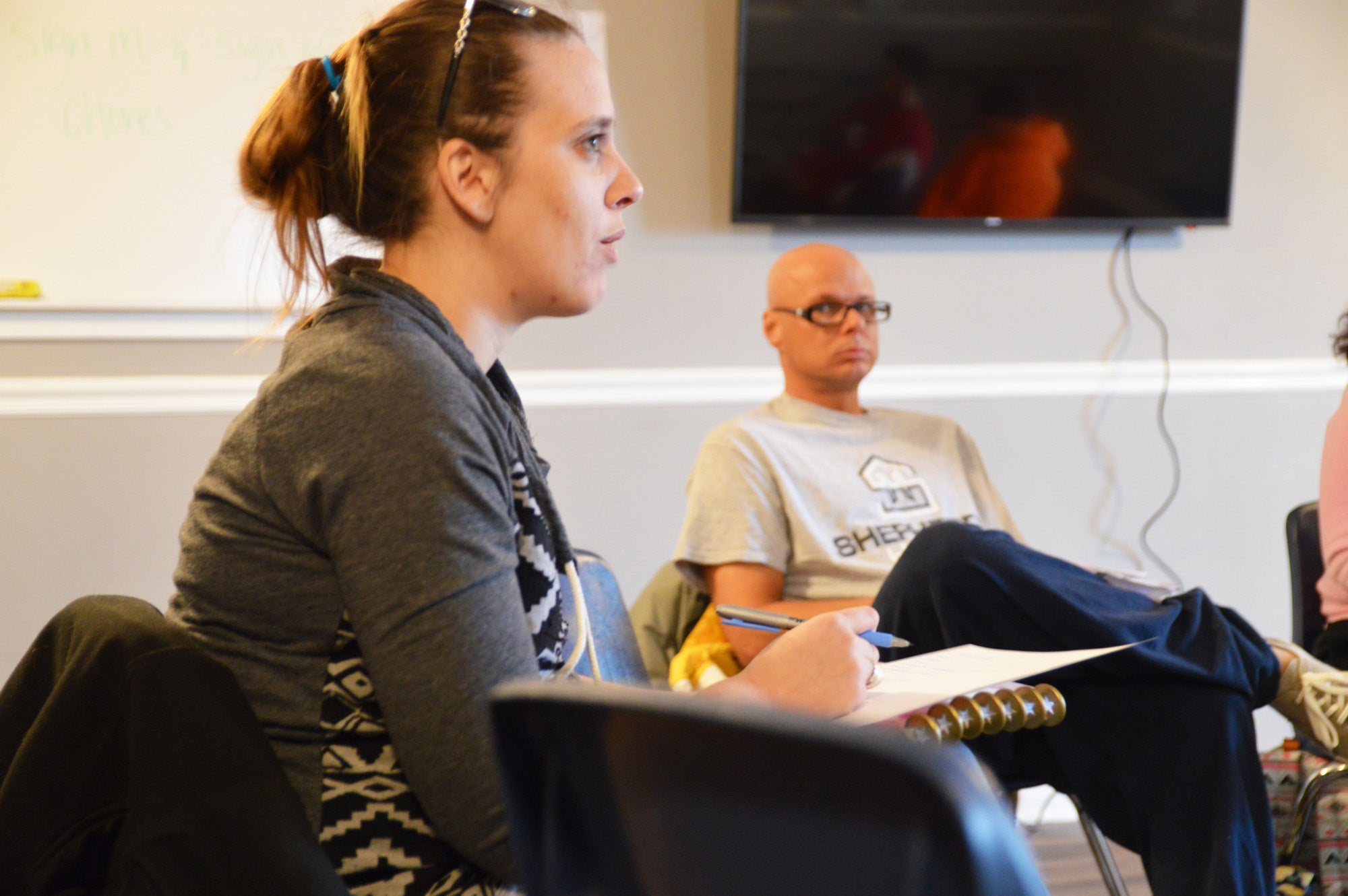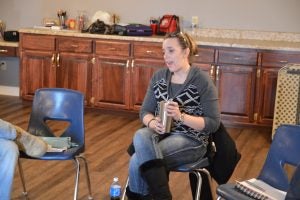Kentucky mom used meth to get off heroin, and it nearly cost her everything
Published 7:10 pm Monday, January 14, 2019

- Photos by Bobbie Curd/bobbie.curd@amnews.com Amanda Grant talks about her triggers during group session at Shepherd’s House, as peer Jeremy listens.
Editor’s note: This is the first in a series about methamphetamine, its effect on users and why some say the drug is seeing a major comeback. Part two will appear in tomorrow’s paper.
Amanda Grant sits comfortably on the couch inside the Shepherd’s House. She is a former drug user undergoing addiction treatment in the non-residential program for former inmates. She looks a little tired but glows when she talks about her road to sobriety and the work she’s done on herself, how she now lives for her kids and God.
She took a hard path getting here, Grant admits, by treating herself with meth so she could kick heroin.
“As crazy as it sounds — and I know it does — the meth helped me get off heroin,” Grant says. With all that was happening — she knew about multiple heroin overdoses and fentanyl deaths — she says she knew she’d probably die. So she treated herself with meth as an upper to get through the heroin withdrawal.
But she found herself with a new addiction to meth, and this new addiction would also threaten her life.
Since heroin has been in the spotlight and is becoming harder to get, some say it’s leaving the gate open for meth to hit the area harder.
Meth is a stimulant affecting the central nervous system and chemicals responsible for brain overactivity. Health officials and authorities say the effects on the body and methods for dealing with people using meth are completely different from heroin; heroin is a depressant.
And that’s why Grant started using it. A single mom, she says she always kept a job down and provided for her kids. Then she tried heroin and got hooked.
Meth’s history
Amphetamine was first introduced to the mainstream public by the pharmaceutical industry. In the ‘50s, doctors prescribed it as a diet pill and an antidepressant; it was used by college students, truck drivers, athletes … then it became a problem.
It became even more of a problem in the ‘60s when an injectable form hit the streets, according to the Foundation for a Drug Free World. The foundation says that in ‘70, the government made it illegal for “most” uses through the Controlled Substances Act, which classified all forms of amphetamines as Schedule II drugs. That means there’s a strong abuse/dependency warning, but it can still be used for some medical reasons, including treating kids for attention deficit disorders.
Chemically, amphetamines and meth have similar structures; but one of those differences allows meth to enter the brain more quickly, creating a more intense high, making users more susceptible to addiction.
Homemade meth became a popular drug in rural areas, where people weren’t able to afford cocaine.
In 1996, Congress passed the Comprehensive Methamphetamine Control Act, regulating mail order and chemical companies supplying the ingredients required to make meth.
Then, the Combat Methamphetamine Epidemic Act of 2005 (actually included in the Patriot Act of ‘06) banned over-the-counter sales of drugs used to make meth, such as Sudafed.
Meth was actually developed in the late 1800s, and was first used by several countries in World War II to help soldiers stay awake; several reports say it was given to Japanese kamikaze pilots before their suicide missions.
The Substance Abuse and Mental Health Services Administration, a branch of the U.S. Department of Health and Human Services, shows the use of meth increasing for all ages (from 12 to over 26 years old) in its ‘16-’17 National Survey on Drug Use and Health. The biggest increase was in ages 18-25, from .8 to 1.1 percent — an increase of an additional 110,000 people using meth in that age range.
Amanda’s story
Grant, 28, was first hooked on using opiates in the form of pain pills, snorting and injecting. She did a few stints in jail, staying clean each time, but not for long after getting out.
She tried heroin and immediately became addicted. She overdosed twice.
“And the last time I OD’d, I’d say it was cut with fentanyl,” she says, referring to the synthetic opiate responsible for a cluster of deaths in Boyle County in 2016. Both her young children were present when she OD’d, which was the breaking point for her, she says.
She spoke to a friend who was also addicted, and they decided they had to shake it or they were going to die.

Bobbie Curd/bobbie.curd@amnews.com
Amanda Grant, 28, discussed how she came to use methamphetamine. She is working on her sobriety through Shepherd’s House, a non-residential treatment program for former inmates.
“So I did my first shot of meth,” she says. Working in a factory, she was able to do the drug and work well, along with going without sleep and barely any food, for up to four days — after just one shot. No one noticed a change in her.
“Day five, I woke up and I no longer needed heroin,” Grant says. People don’t realize how incredibly sick heroin addicts get coming off the drug, she says — it feels like you’re literally dying. She felt like she’d finally beaten withdrawal.
“I wasn’t even getting high anymore, I was just staying up and keeping it going. Being a mom, keeping a house going and a full-time job with overtime, getting everything done …”
She hasn’t used opiates since May 9, 2015. But she had gotten hooked on meth. And it had far surpassed the “buzzed” or “hyper” feeling — she needed it every day just to keep going.
“For me, meth was a simple solution. I can do one shot of meth a day, instead of several a day of heroin. But I just continued, and it became a cycle.”
And just as with heroin, for meth users, everything becomes about the next hit. Her responsibilities started falling by the wayside. She’d find herself driving around town for hours on end, figuring out how to find money to buy her next hit.
Then, she found out there was a warrant out for her arrest for theft charges from when she was using heroin. She quit her job and went on the run for 30 months.
“And, obviously, through my IV use, I got hepatitis C,” Grant says.
She ended up back in jail in July of 2017, made it into the Shepherd’s House in October and graduated from the program in April of 2018. Then, she relapsed in May, and jumped off the Chenault Bridge in Garrard County while hanging out with some friends.
She doesn’t remember much of the incident, but friends tell her she floated up, face-down before they pulled her out and called EMS.
She was arrested again, and went back to treatment in June. Then, after getting sick and going to the ER, a nurse called Child Protective Services after seeing the track marks on her arm.
“I wasn’t high at the time, but I had used a couple of times,” Grant says. She says she felt like some of her civil rights were violated the way the situation was handled, but now that she’s had time to digest it, she’s not angry at the nurse.
“I’m glad she made that call. It got me back on track.” She came back to the Shepherd’s House program on her own. She’s been clean since November.
After lots of therapy, group sessions and soul searching, Grant realizes growing up with addiction in her family affected her on many levels. She wants her two kids, now 9 and 6, to know stability.
“My kids — my kids were there during my last overdose, and they know what happened,” she says.
Throughout her addiction, she almost lost everything; she lost homes, jobs — “I lost my soul.”
“I’m not here to glorify meth, either, and say it’s anywhere near lifesaving,” she says. Treating her meth addiction has been hard, to say the least.
She’s had to let go of all of her old friends she used with, something she hates but knows it had to be done. They’re not bad people, she says, they just haven’t made the decision to come clean — and no one can do that for them.
“For the first time in almost 10 years, I’m completely out of the court system. I’m done, and I’m free, and it’s priceless,” Grant says. She still struggles, and there are days she still wants to get high. But, now she says she knows she doesn’t have to.
“If I get stressed out, and feel like I can’t get done what I need to get done, that’s when I want to use,” Grant says during a group session at Shepherd’s House. “So I just take it day by day. If I can’t get to something today, it’ll be there tomorrow. That’s all I can do.”






